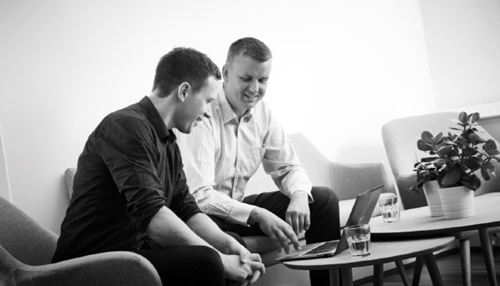Agency360
Why you should split test Facebook Ads to create the very best campaign
apr. 27, 2020

Agency360
Many different aspects contribute to a successful Facebook ad campaign. However, what makes it even more successful is if you understand the reasoning behind the success of the campaign. What made that specific campaign more profitable than the others you launched? Was it the eye-catching image, or maybe the funny text? Is there a way to make the ad even more effective?
What determines a high-quality backlink?
There are a few different elements that make links high-quality backlinks. Backlinking can majorly increase your SEO strategy without putting in a lot of effort. Check out the three most important aspects to determine high-quality backlinks.
Many different aspects contribute to a successful Facebook ad campaign. However, what makes it even more successful is if you understand the reasoning behind the success of the campaign. What made that specific campaign more profitable than the others you launched? Was it the eye-catching image, or maybe the funny text? Is there a way to make the ad even more effective?
An easy split test Facebook Ad allows you to gain valuable insights into your audience’s behaviour and the performance of your current strategy. Just like Obama amassed 60 million dollars on his campaign by split testing, you can also reap the benefits.
In other words, by using the Facebook Ads A/B testing feature, you can develop a successful campaign by eliminating the unfavourable variables and increasing your ad performance. Read our key tips to make your ad even more awesome!
But why split test Facebook Ads?
Closely analysing your ads is the best way to understand why your campaign is successful or, perhaps, falling short of your expectations. Split test Facebook Ads can show you which ad layout works best for your campaign and which option is the most cost-effective. Facebook Ads A/B testing calculates the cost per result of both test ads, and the option with the lowest cost per result wins.
These types of results obtained from a Facebook Ad split test are of high value and provide you with detailed information that you can apply to your current ad campaign.
Facebook Ads split test lessens the risk of running an ineffective campaign. Running an ad that is not as great as you first thought is a waste of time, money and resources. A simple Facebook Ads split test will save you money in the long run and reduce wasted resources.
Less wasted time, more efficiency and more success
You will be testing what has the most outcome and impact for your campaign with a Facebook Ads split test, giving you insights into your campaign’s strengths and weaknesses. This knowledge is powerful and gives you a great indication of what is profitable and what is not.
You can focus on creating profitable ads that include previously successful variables, or strong assets of the test ad. This makes your decision-making process quicker and more agile. For example, you can decide not to use image A in your current or future campaigns, as it was not successful in past split tests and did not reap great results.
By choosing the more popular picture from your Facebook Ads split test, you will see your ad perform better when you run it, giving you a better campaign performance and ROI.
Put your variables to the test
When you split test Facebook Ads, the system allows you to test the following variables; creative, audience, delivery optimisation or placement. These all play an important role in your campaign and can have a huge impact on the overall success of your ad.
- Creative covers the content and artistic side of things, like images, videos, call to actions etc. Like we mentioned above, your CTA and image may differ depending on your target audience or the position of your audience in their customer journey with your brand.
- Audience is useful if you want to gain insight and knowledge about your ideal customer. You can change elements within the audience setting such as age, gender, relationship status etc.
- Delivery is used to tell Facebook what your ad goals are and how they can deliver them through the platform. For example, say your goal is to increase the number of app installations through Facebook. Well, the algorithm will show your ad to the users who have previously displayed this type of behaviour and will most likely download your app through Facebook.
Most of the time, the end goal is conversions, but of course, this can vary depending on your campaign or business. This is a valuable variable in split testing Facebook Ads.
- Placement is where you would want your ad to be seen or placed, for example on Instagram (feed or stories) or Facebook newsfeeds (mobile or desktop). Your placement may vary depending on your target audience. However, you can then split test Facebook Ads to see which placement gains the most outcome.
3 easy tips for Facebook Ads split test
1. Image is everything
Images play a huge part in the success of an ad because they catch the users’ attention. When it comes to Facebook Ads A/B testing, it can be hit or miss. Generally, the more vibrant, colourful image is the most successful when you split test Facebook Ads.
Testing colour is the perfect example of a variable you could experiment within your Facebook Ad test. Colours evoke different emotions and portray different feelings and connotations. For example, green is fantastic for environmental brands and blue is effective at evoking trust.
However, consider how your ad will look on newsfeeds, as it may blend into Facebook’s own colour scheme. You can read more about emotions and colour here.
Remember to keep everything else the same when you split test Facebook Ads. Run your two differently coloured image tests and do not change any of the other elements. For example, the same test duration, text and title etc.
When you change other variables at the same time, you will cause inconclusive and inaccurate Facebook Ad split test results.
2. Play with your body text
Having an effective body text is hugely important when it comes to grabbing your audiences’ attention. This body of text will prompt your reader to click your link or want to know more about your product or service. Therefore, it is a great idea to split test Facebook Ads by body text.
For example, you could try testing a testimonial piece of text and its impact on your conversion rate. It might also be worth testing different tones if your text is not converting well.
Since 80% of purchases are emotional, you could try focusing on the emotional side of your product or service. Then do a Facebook Ad split test to investigate which image will create a more effective ad.
3. Call out your call to action
Having an effective CTA can increase your click-through rates by 285%, so you have to pick the correct one for your brand. The good thing about Facebook is that it allows you to split test Facebook Ads from a different variety of call to action buttons for testing.
Keep in mind when choosing a call to action button, to choose the most appropriate for your audience. Also bear in mind their position in the customer journey. For example, maybe avoid using the “shop now” button, as it seems very pushy and forceful if your audience has never heard of your brand before.
Different call to actions will have different results. Split test Facebook Ads by choosing “sign up now” or “learn more”. The results from your Facebook Ads split test will give you an idea of which works best for your audience. To understand whether your audience is receptive or not, keep an eye on your engagement metrics.
Using your results wisely
After you have split tested your ad, it’s time to put your Facebook Ads split test results to good use. You should receive an email from Facebook containing a complete breakdown of all of your results. This data is extremely valuable and gives a closer insight into your campaign strategy. You should be using these results to their full potential.
Optimise and build on your existing ads
The results from your Facebook Ads split test will show you the data behind why your ad was effective. After you have absorbed the information, you can then start to develop a new ad. Your new ad should contain these successful elements to create an even better campaign! By utilising these insights, you can optimise your ad and increase your campaign’s performance.
By concentrating on your successful elements, you can work more efficiently at creating campaigns. Focusing your time and resources into further developing only within the successful variables.







